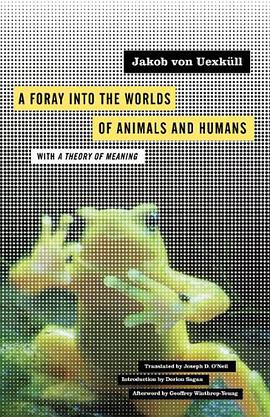A Foray into the Worlds of Animals and Humans
Douban
with A Theory of Meaning
Jakob von Uexküll Übersetzer/in: Joseph D. O’Neil
Übersicht
The influential work of speculative biology—and a key document in posthumanist studies—now available in a new, accurate English translation
In A Foray into the Worlds of Animals and Humans, the pioneering biophilosopher Jakob von Uexküll embarks on a remarkable exploration of the unique social and physical environments that individual animal species, as well as individuals within species, build and inhabit. Uexküll’s concept of the umwelt holds new possibilities for the terms of animality, life, and the framework of biopolitics.
“Is the tick a machine or a machine operator? Is it a mere object or a subject?” With these questions, the pioneering biophilosopher Jakob von Uexküll embarks on a remarkable exploration of the unique social and physical environments that individual animal species, as well as individuals within species, build and inhabit. This concept of the umwelt has become enormously important within posthumanist philosophy, influencing such figures as Heidegger, Merleau-Ponty, Deleuze and Guattari, and, most recently, Giorgio Agamben, who has called Uexküll “a high point of modern antihumanism.”
A key document in the genealogy of posthumanist thought, A Foray into the Worlds of Animals and Humans advances Uexküll’s revolutionary belief that nonhuman perceptions must be accounted for in any biology worth its name; it also contains his arguments against natural selection as an adequate explanation for the present orientation of a species’ morphology and behavior. A Theory of Meaning extends his thinking on the umwelt, while also identifying an overarching and perceptible unity in nature. Those coming to Uexküll’s work for the first time will find that his concept of the umwelt holds new possibilities for the terms of animality, life, and the framework of biopolitics.
contents
Contents
Introduction: Umwelt after Uexküll
Dorion Sagan
Translator’s Introduction
A Foray into the Worlds of Animals and Humans
Foreword
Introduction
Environment Spaces
The Farthest Plane
Perception Time
Simple Environments
Form and Movement as Perception Marks
Goal and Plan
Perception Image and Effect Image
The Familiar Path
Home and Territory
The Companion
Search Image and Search Tone
Magical Environments
The Same Subject as Object in Different Environments
Conclusion
A Theory of Meaning
Carriers of Meaning
Environment and Dwelling-shell
Utilization of Meaning
The Interpretation of the Spider’s Web
Form Development Rule and Meaning Rule
The Meaning Rule as the Bridging of Two Elementary Rules
The Composition Theory of Nature
The Sufferance of Meaning
The Technique of Nature
Counterpoint as a Motif/Motive of Form Development
Progress
Summary and Conclusion
Afterword. Bubbles and Webs: A Backdoor Stroll through the Readings of Uexküll
Geoffrey Winthrop-Young
Notes
Index